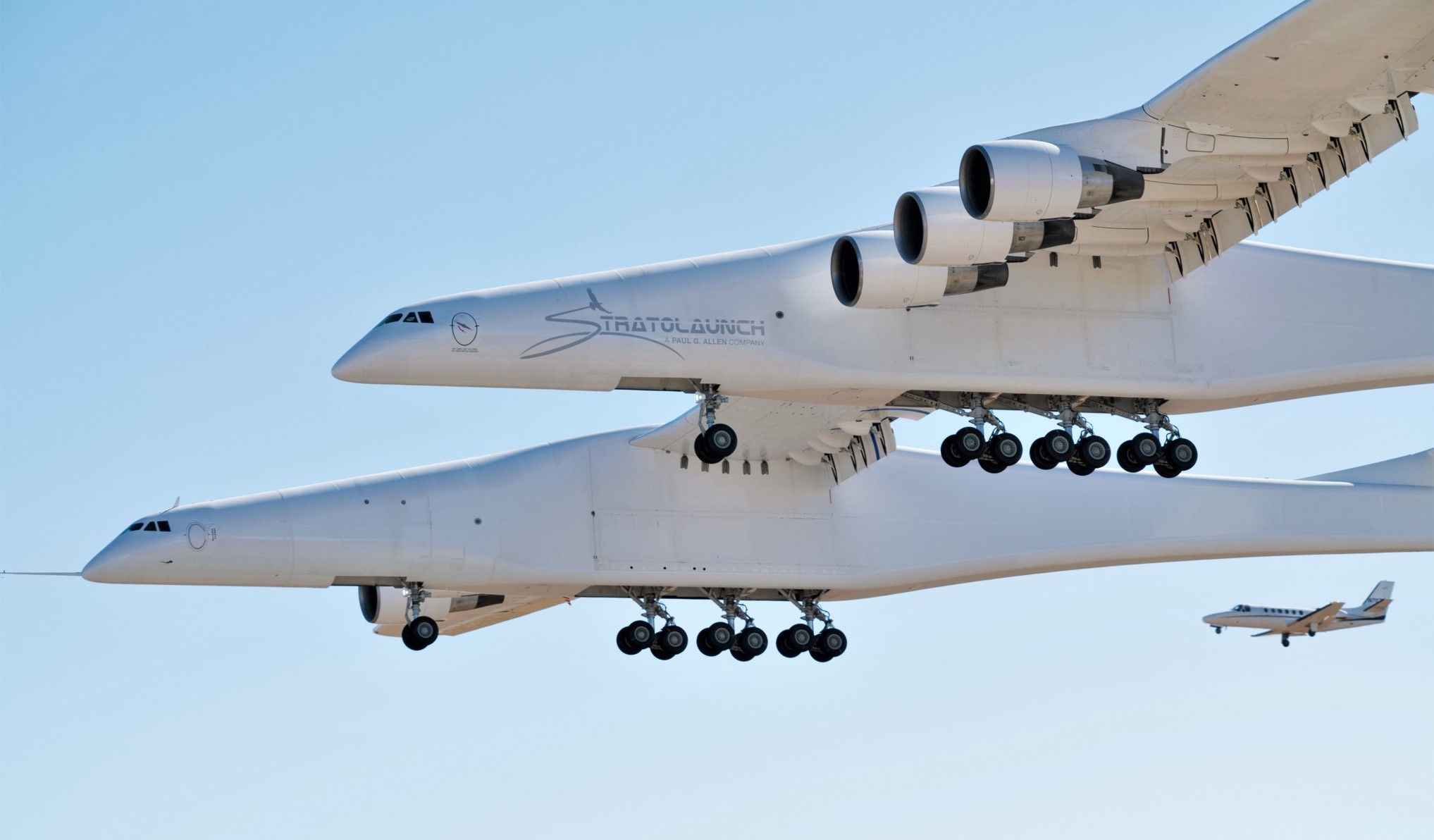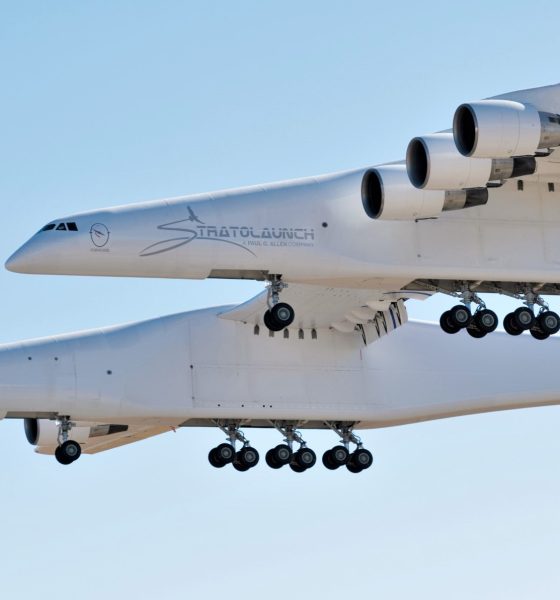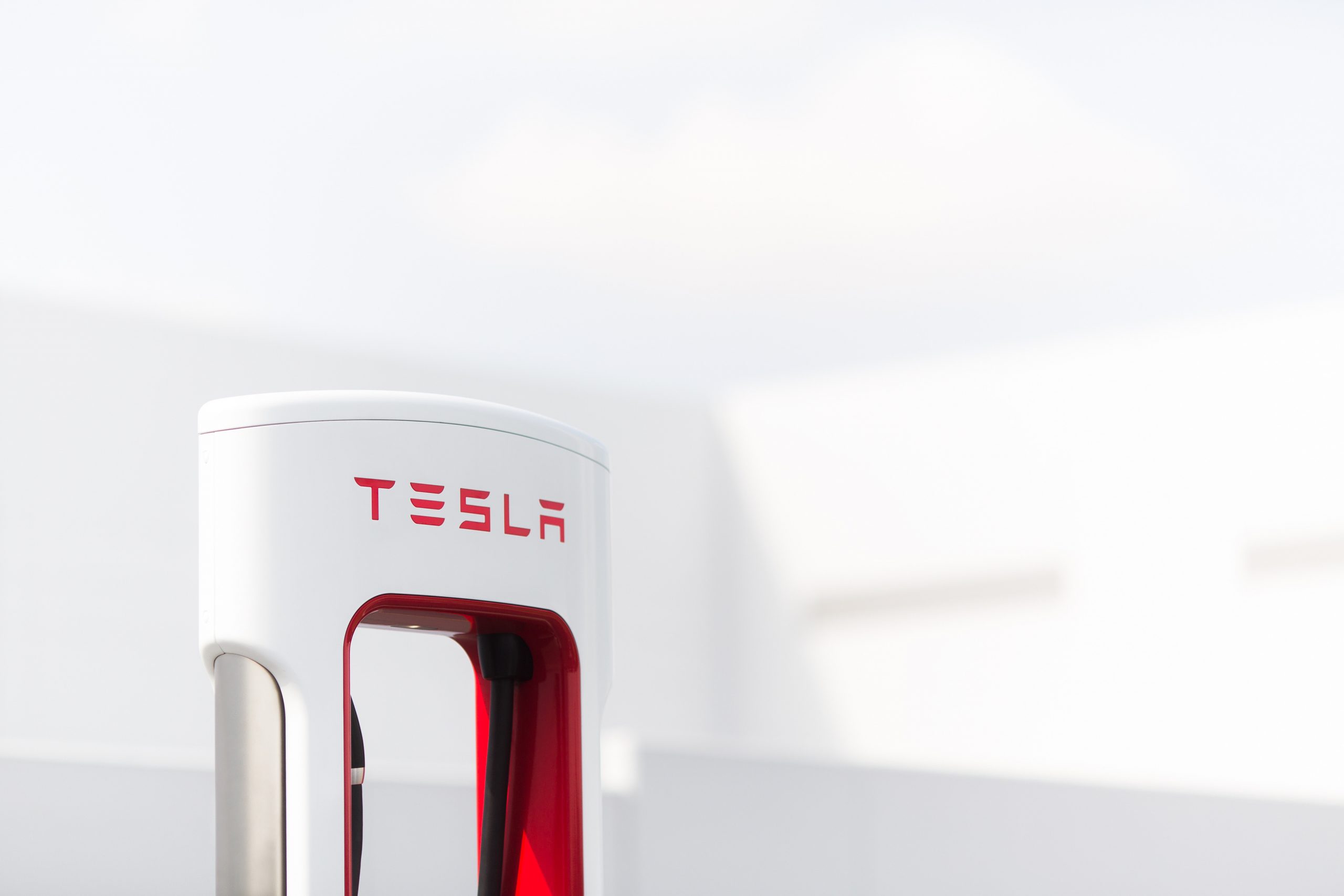

News
Stratolaunch sold to mystery buyer, raising hopes that world’s largest plane will fly again
Stratolaunch Systems Corp. – a space launch venture created by the late Microsoft co-founder billionaire Paul Allen – debuted the world’s largest plane (nicknamed Roc) in April 2019, completing one flawless flight before reports of its indefinite grounding arose.
In June, parent holding company Vulcan Inc. – led by Allen’s sister after his death – planned to cease Stratolaunch’s operations in anticipation of a total liquidation – including the aircraft, intellectual property, and facilities – worth up to $400 million. However, the Roc may live to fly once again after an official October 11th announcement, in which Stratolaunch indicated that the company has “transitioned ownership and is continuing regular operations.”
Prior to the announcement, NASASpaceflight.com photographer Jack Beyer posted photos to twitter appearing to show new activity at Stratolaunch’s Mojave Air and Space Port hangar. The post garnered a response from Nicola Pecile – test pilot with Virgin Galactic – who stated that operations seem likely to resume “in a few weeks” citing that hiring notices were recently sent to members of the Society of Experimental Test Pilots (SETP).
Initially, Allen developed the company to launch air-to-orbit rockets from a carrier aircraft mid-flight. To say that Stratolaunch has experienced turbulence during development may be an understatement. Since its inception, conceptualization redesigns and failed partnerships with various rocket launch vehicle companies have plagued operational efforts.
In 2011 Stratolaunch partnered with Elon Musk’s SpaceX to develop a multi-stage launch vehicle named the Falcon 9 Air that would be dropped from a carrier aircraft. The Falcon 9 Air would have been capable of delivering payloads up to 6,100kg (13, 400lbs) to low Earth orbit (LEO) from flight altitudes of 30,000ft with the assist of 4 Merlin 1D engines – the same engines that now propel SpaceX’s Falcon 9 and Falcon Heavy boosters.
In 2012 SpaceX and Stratolaunch amicably parted ways with SpaceX citing design alterations that no longer worked with their envisioned Falcon 9 Air launch vehicle.

Following the dissolution of the partnership with SpaceX, Stratolaunch partnered with Orbital Sciences Corp (Orbital ATK) – now a subsidiary of Northrop Grumman – to develop the Pegasus II which was ultimately shelved to pursue in-house developed launch vehicles. Following the death of Paul Allen in 2018 that plan was also abandoned as Allen’s sister, Jody Allen, set an exit plan for the company in early 2019 according to Reuters.
However, the recent buy out by a mystery purchaser has seemingly breathed new life into Stratolaunch as the Twitter announcement also mentioned that the company will now “bring the carrier aircraft test and operations program fully in-house.” What this means for the future of the Roc and any air-to-orbit launches remains unclear.
The Roc itself is comprised of twin fuselages connected by a reinforced center wing and features an incredible wingspan of 117m (385ft), 28 landing gear wheels, and six Pratt & Whitney PW4056 engines – as well as many other components – salvaged from donor Boeing 747-400s. It is both the largest and heaviest aircraft (excluding payload) to have ever flown.
With a nickname derived from a mythical bird so large it could carry an elephant in flight, it would have been a tragedy if the one-of-a-kind aircraft were to be scrapped, mothballed, or placed in a museum after just a single flight. With Hope Stratolaunch’s October 11th announcement, the future of the massive plane has thankfully stabilized in spite of significant uncertainty, and hope remains that Roc’s new owner(s) will find a way to continue flying the aircraft.
Check out Teslarati’s newsletters for prompt updates, on-the-ground perspectives, and unique glimpses of SpaceX’s rocket launch and recovery processes.

News
Tesla FSD’s newest model is coming, and it sounds like ‘the last big piece of the puzzle’
“There’s a model that’s an order of magnitude larger that will be deployed in January or February 2026.”

Tesla Full Self-Driving’s newest model is coming very soon, and from what it sounds like, it could be “the last big piece of the puzzle,” as CEO Elon Musk said in late November.
During the xAI Hackathon on Tuesday, Musk was available for a Q&A session, where he revealed some details about Robotaxi and Tesla’s plans for removing Robotaxi Safety Monitors, and some information on a future FSD model.
While he said Full Self-Driving’s unsupervised capability is “pretty much solved,” and confirmed it will remove Safety Monitors in the next three weeks, questions about the company’s ability to give this FSD version to current owners came to mind.
Musk said a new FSD model is coming in about a month or two that will be an order-of-magnitude larger and will include more reasoning and reinforcement learning.
He said:
“There’s a model that’s an order of magnitude larger that will be deployed in January or February 2026. We’re gonna add a lot of reasoning and RL (reinforcement learning). To get to serious scale, Tesla will probably need to build a giant chip fab. To have a few hundred gigawatts of AI chips per year, I don’t see that capability coming online fast enough, so we will probably have to build a fab.”
NEWS: Elon Musk says FSD Unsupervised is “pretty much solved at this point” and that @Tesla will be launching Robotaxis with no safety monitors in about 3 weeks in Austin, Texas. He also teased a new FSD model is coming in about 1-2 months.
“We’re just going through validation… https://t.co/Msne72cgMB pic.twitter.com/i3wfKX3Z0r
— Sawyer Merritt (@SawyerMerritt) December 10, 2025
It rings back to late November when Musk said that v14.3 “is where the last big piece of the puzzle finally lands.”
With the advancements made through Full Self-Driving v14 and v14.2, there seems to be a greater confidence in solving self-driving completely. Musk has also personally said that driver monitoring has been more relaxed, and looking at your phone won’t prompt as many alerts in the latest v14.2.1.
This is another indication that Tesla is getting closer to allowing people to take their eyes off the road completely.
Along with the Robotaxi program’s success, there is evidence that Tesla could be close to solving FSD. However, it is not perfect. We’ve had our own complaints with FSD, and although we feel it is the best ADAS on the market, it is not, in its current form, able to perform everything needed on roads.
But it is close.
That’s why there is some legitimate belief that Tesla could be releasing a version capable of no supervision in the coming months.
All we can say is, we’ll see.
Investor's Corner
SpaceX IPO is coming, CEO Elon Musk confirms
However, it appears Musk is ready for SpaceX to go public, as Ars Technica Senior Space Editor Eric Berger wrote an op-ed that indicated he thought SpaceX would go public soon. Musk replied, basically confirming it.

Elon Musk confirmed through a post on X that a SpaceX initial public offering (IPO) is on the way after hinting at it several times earlier this year.
It also comes one day after Bloomberg reported that SpaceX was aiming for a valuation of $1.5 trillion, adding that it wanted to raise $30 billion.
Musk has been transparent for most of the year that he wanted to try to figure out a way to get Tesla shareholders to invest in SpaceX, giving them access to the stock.
He has also recognized the issues of having a public stock, like litigation exposure, quarterly reporting pressures, and other inconveniences.
However, it appears Musk is ready for SpaceX to go public, as Ars Technica Senior Space Editor Eric Berger wrote an op-ed that indicated he thought SpaceX would go public soon.
Musk replied, basically confirming it:
As usual, Eric is accurate
— Elon Musk (@elonmusk) December 10, 2025
Berger believes the IPO would help support the need for $30 billion or more in capital needed to fund AI integration projects, such as space-based data centers and lunar satellite factories. Musk confirmed recently that SpaceX “will be doing” data centers in orbit.
AI appears to be a “key part” of SpaceX getting to Musk, Berger also wrote. When writing about whether or not Optimus is a viable project and product for the company, he says that none of that matters. Musk thinks it is, and that’s all that matters.
It seems like Musk has certainly mulled something this big for a very long time, and the idea of taking SpaceX public is not just likely; it is necessary for the company to get to Mars.
The details of when SpaceX will finally hit that public status are not known. Many of the reports that came out over the past few days indicate it would happen in 2026, so sooner rather than later.
But there are a lot of things on Musk’s plate early next year, especially with Cybercab production, the potential launch of Unsupervised Full Self-Driving, and the Roadster unveiling, all planned for Q1.
News
Tesla adds 15th automaker to Supercharger access in 2025

Tesla has added the 15th automaker to the growing list of companies whose EVs can utilize the Supercharger Network this year, as BMW is the latest company to gain access to the largest charging infrastructure in the world.
BMW became the 15th company in 2025 to gain Tesla Supercharger access, after the company confirmed to its EV owners that they could use any of the more than 25,000 Supercharging stalls in North America.
Welcome @BMW owners.
Download the Tesla app to charge → https://t.co/vnu0NHA7Ab
— Tesla Charging (@TeslaCharging) December 10, 2025
Newer BMW all-electric cars, like the i4, i5, i7, and iX, are able to utilize Tesla’s V3 and V4 Superchargers. These are the exact model years, via the BMW Blog:
- i4: 2022-2026 model years
- i5: 2024-2025 model years
- 2026 i5 (eDrive40 and xDrive40) after software update in Spring 2026
- i7: 2023-2026 model years
- iX: 2022-2025 model years
- 2026 iX (all versions) after software update in Spring 2026
With the expansion of the companies that gained access in 2025 to the Tesla Supercharger Network, a vast majority of non-Tesla EVs are able to use the charging stalls to gain range in their cars.
So far in 2025, Tesla has enabled Supercharger access to:
- Audi
- BMW
- Genesis
- Honda
- Hyundai
- Jaguar Land Rover
- Kia
- Lucid
- Mercedes-Benz
- Nissan
- Polestar
- Subaru
- Toyota
- Volkswagen
- Volvo
Drivers with BMW EVs who wish to charge at Tesla Superchargers must use an NACS-to-CCS1 adapter. In Q2 2026, BMW plans to release its official adapter, but there are third-party options available in the meantime.
They will also have to use the Tesla App to enable Supercharging access to determine rates and availability. It is a relatively seamless process.








